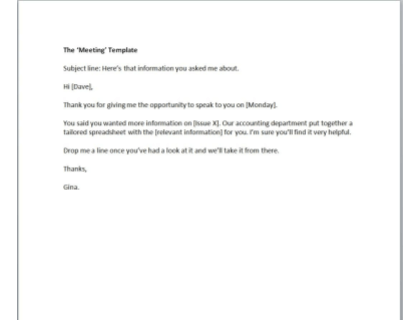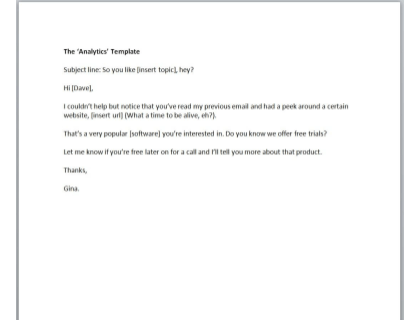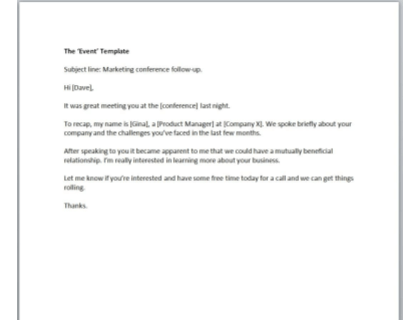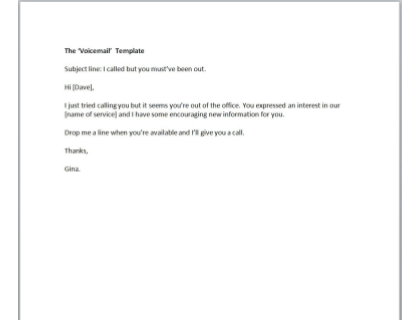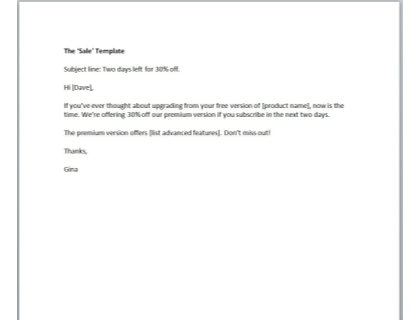Follow-Up Email Templates
Get free follow-up email downloadable templates, as well as best practices for crafting persuasive follow-up emails that drive sales.
Updated on August 4th, 2022
The SMB Guide is reader-supported. When you buy through links on our site, we may earn an affiliate commission. Learn more
Follow-up emails are a series of emails sent to customers in the hopes of closing a deal, or converting an interest into action. A follow-up email can attempt to convert leads, obtain additional information, convince a customer to make an additional purchase, or upgrade from a free trial to a paid account.
Follow-up emails bear encouraging statistics. For one, emails without following up have a 9% reply rate, while emails with a follow-up have a rate of 13%. In certain cases, follow-up emails enjoy a higher response rate than initial emails, which points to the value of persistence with cold emailing.
Follow-up emails are tricky. You're not happy waiting for a reply that may never come but you also don't want to appear pushy, obtrusive, or passive-aggressive; possibly sabotaging a sale. So how do you strike that balance? This article describes best practices for writing follow-up emails and offers useful free templates to download that are proven at getting responses.
Follow-Up Email Best Practices:
Be patient. A follow-up email will not always get an immediate response. Play the long game by being consistent in following-up over time.
Do not exceed three follow-up emails. Some email marketers believe that two follow-up emails without a response is enough to suggest your customer is indifferent to your service, and was probably only looking for something free from the outset, so use your discretion if you feel there's still the potential for a sale.
Don't send the follow-up too soon after the initial email. Remember that with email, the recipient has the luxury of responding in their own time. Besides, it's easy to come across as too pushy. Wait 2-3 days after your first follow-up email before sending the next, and always extend the waiting period between each new follow-up.
When sending a second or third follow-up, be sure to always add new information, or approach them from a fresh angle. Drip-feed them information that might interest them.
The subject line will, in most cases, determine whether a potential customer opens your email or scrolls by. Write a subject line that intrigues them, and avoid generic introductions.
The best sending times should be determined by you. Look into your email marketing data. You might spot a trend that tells you emails with the highest response rates are the ones sent on a Monday morning, for example.
Your follow-up email needs to do something different to your initial email. Your follow-up email won't achieve a response if the customer feels it's a repetition of the initial email in terms of structure.
Like your initial email, your follow-up email should be concise and to the point. Be sure to keep them under 200 words.
Determine your follow-up objective. Make it simple and clear, and see to it that your follow-up email only tries to achieve one thing.
5 Effective Follow-Up Email Templates:
Type of Follow-Up Email | Strategy |
|---|---|
Follow up after a meeting in person by giving them additional information. | |
Acknowledge their interest in your services by asking them about it. | |
Follow up after an industry event. | |
Follow a voicemail with an email for an effective combination. | |
Alert them to a narrow window of opportunity in which to make a purchase on sale. |
The "Meeting" Template:
This email is sent after an initial meeting where you made a sales pitch to a potential client. The client might've given you an encouraging response, but a few days have now passed without any further communication. This is a common situation. The "Meeting" template is the equivalent of a throat-clearing "ahem," signaling an attempt to remind them of their pending response.
Try not to explicitly remind them that you're waiting for a reply. Instead, frame the message as a new development in the process. For example, put together a spreadsheet or presentation that is tailored to them. Let them see the effort you've put into the deal so that they feel obliged to respond in kind.
The "Meeting" Template
Check out our "Meeting" Follow-Up Email Template in Microsoft Word format.
The "Analytics" Template:
Your email marketing software should have an analytics dashboard that tells you when someone has read an email, whether they've clicked on any links, and what they did on that web page. If you notice that someone has read your email and followed a link to your web page, but did not convert that action into a sale, you might want to drop them an email asking them if they need any help.
People take data privacy very seriously, as they should, and emails that give people the impression that they're being tracked online don't typically sit well with them. To overcome this, simply acknowledge it. Address the creepy nature of the email with self-deprecating humor about the state of technology. This tactic might disarm the recipient, who might have felt a sense of intrusion at first.
The "Analytics" Template
Check out our "Analytics" Follow-Up Email Template in Microsoft Word format.
The "Event" Template:
This follow-up has the advantage of happenstance. You never cold emailed anyone looking for a lead, or gave a sales pitch in a company meeting room. You simply attended the same event and had an interesting conversation. Half your job is done. What's left now is to send them an email that consolidates the relationship. Tell them you were glad to have run into them, and that you're keen on hearing more about what they had to say.
The key here is to strike while the iron is hot. Don't wait too long after the event to send the follow-up. Get it in their inbox the very next day. It might be helpful to reintroduce yourself in case the client has forgotten your name or the company you work for.
The "Event" Template
Check out our "Event" Follow-Up Email Template in Microsoft Word format.
The "Voicemail" Template:
Leaving both a voicemail and a follow-up email is the classic jab-right hook of the email marketing world. Voicemail and email are often ignored individually, but a voicemail and email one-two enjoys much higher response rates. It tells them that you tried reaching out to them that but they weren't available, so you thought it would be more convenient to drop them an email.
The "Voicemail" Template
Check out our "Voicemail" Follow-Up Email Template in Microsoft Word format.
The "Sale" Template:
No one likes missing out on a sale. It's almost too easy to provoke action by alerting a customer to a narrow window of opportunity in which to save money (assuming the customer is interested in the product).
Most of your work is done in the subject line. Do nothing other than say how much is off and for how long. The body of the email should, very concisely, describe the benefits of making the purchase.
The "Sale" Template
Check out our "Sale" Follow-Up Email Template in Microsoft Word format.
Pros and Cons:
Pros
- You are more likely to be remembered if you follow-up after an initial email.
- It demonstrates initiative to your prospective client.
- It separates you from the rest of the cold-emailing pack.
- Statistically, you have a better chance of a reply if you follow-up.
Cons
- It's very easy to sabotage a potential sale by coming across as pushy.
- There is the potential to become rude after no reply, creating a negative impression of your business.
- If you don't do it right, it's easy to project an air of desperation.
- There is the potential to breach the CAN-SPAM Act regulations and incur heavy penalties.
Sales Strategies
Learn more about creating and implementing sales strategies. Includes a free sales strategy template and examples of each strategy.
Feb 2, 2023
FAQs:
How do you write a follow-up email?
Follow-up emails differ according to context, but there are some basic guidelines that are common to all. Some common best practices for follow-up emails include allowing enough time between follow-up emails, not exceeding three follow-up emails without a response, and not being repetitive.
How do you follow up after no response?
- Allow more time to pass than the time between your first follow-up.
- Offer something new. Drip-feed them information so that you can send emails with new information every time.
- Scrutinize your previous follow-up to see if you missed anything important, like a clear call-to-action.
- Refrain from sending emails that terminate a relationship. Accept defeat by desisting.
- Remain cordial, and try not to use language that shows frustration or passive-aggression.
How do you politely remind someone to reply?
The golden rule in reminding someone of a pending reply is to not address the void. Simply fill it with something new. In the "Meeting" template, the void is filled by the inclusion of new information in the form of a spreadsheet or presentation. Informing them of something new subtly reminds them that there is unfinished business.
What is the best way to follow up with customers?
- Drip-feed them information if they haven't replied, so as to avoid repetition.
- Use email analytics to monitor their activity, then ask how you can help.
- Follow-up the day after an industry event.
- Send both a voicemail and an email for an effective combination.
- Alert them to a window of opportunity in which to make a purchase on sale.
How many times should you follow up with a prospect?
It is recommended that you desist after three unanswered emails. If a customer is even remotely interested in buying something, they would have responded by then.
What is a gentle reminder?
A gentle reminder is your way of letting a prospective client know that you're waiting on a reply, without coming across as offensive, annoying, or pushy in any way. Being polite is one part of a larger set of basic rules for sending follow-up emails.

